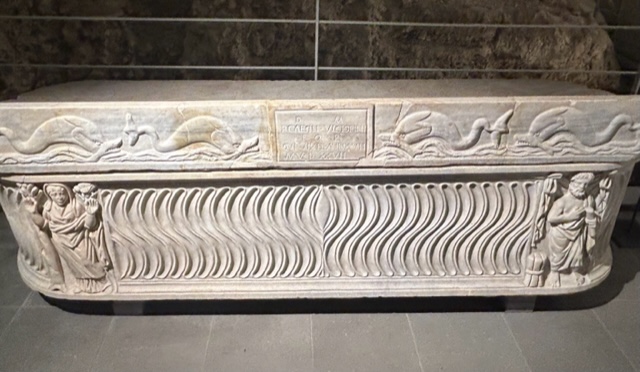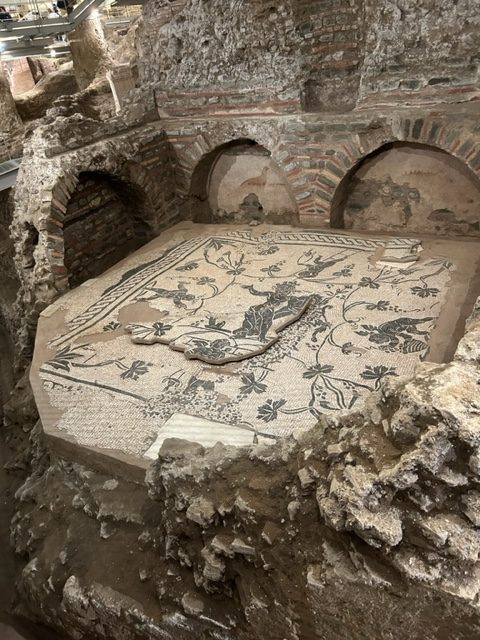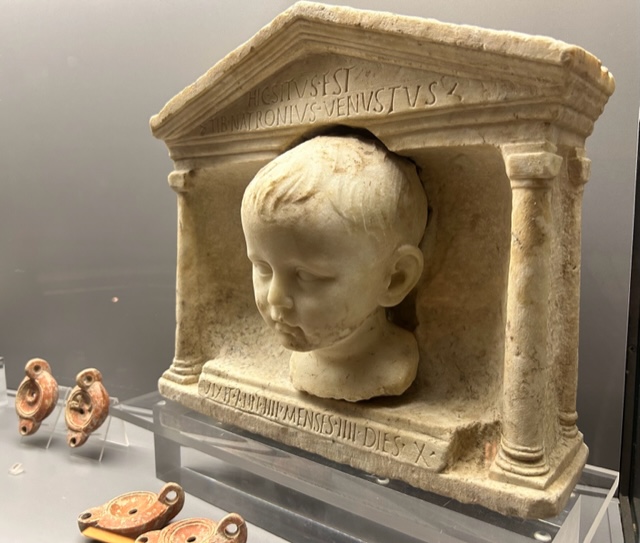In view of 2025’s Jubilee, The Vatican Museums recently opened to individual tourists and pilgrims an ancient Roman pagan necropolis or burial grounds. Previously it had been accessible only to select groups of scholars. Now underground, it was once street-level along the Via Triumphalis, the consular road which led from Rome 16 kms north to Veii, once an important Etruscan city.
Roman law forbade the cremation and burial of the dead within the city for safety and hygienic reasons, but during ancient times, the area where Vatican City is today was outside the city. It was famous for its clay quarries and parks, both private and Imperial. Caligula built his circus here; Domitian his Horti or gardens; and Hadrian his monumental mausoleum, now Castel Sant’Angelo.

With the necropolis’ entrance, separate from the Museums’, at the Porta Santa Rosa on Piazza Risorgimento, the Museums’ intent is to exhibit in situ “Life and Death in the Rome of the Caesars”. For now, only open on Friday afternoons and all-day Saturday, tickets must be booked on the official Vatican Museums website www.vaticanmuseums.va at least 24 hours beforehand.
However, be aware there’s no cloakroom and no accessibility for people with ambulatory problems, for baby strollers or wheelchairs. Full price individual tickets cost 8.50 euros or for a group of up to 25 with a guide 20 euros each. The guided tour, available in English, Spanish, French, German and Italian, lasts an hour and a half. But if you prefer to go at your own speed, don’t worry, the explanations on inter-active video screens, the wall panels, and exhibition cards explain the history and the artifacts clearly both in Italian and in English. Admission to The Vatican Museums (29 euros) is a separate ticket.

The burials in the necropolis of Via Triumphalis (spanning c. 10,764 square feet) are seen above from catwalks. They date from the first century BC to the fourth century AD. Some were unearthed in 1956 by chance during the excavation of the Vatican Autoparco or garage. In 2003 another sector known as “Santa Rosa” was discovered during the construction of a parking lot. Between 2009 and 2011 the two sectors were joined and in 2013 opened to a limited and scholarly public thanks to the generosity of the Canadian Chapter, especially Paul and Carol Hill, of the Patrons of the Arts in the Vatican Museums, while further excavation, conservation, and this year’s musealization are thanks to the Washington DC Chapter.
This necropolis, still being excavated and restored, is unique because of its large size and because it has no tombs belonging to aristocrats. The tombs here, some with frescoes (usually of plants, flowers, and birds, but red snakes indicated the deceased were Egyptian slaves or artisans), mosaic floors, and inscriptions about their owners, often entire families, belong to the lower and middle class: slaves (many of whom belonged to the emperor Nero), liberti or freedmen, and artisans.
Many couldn’t afford to build a tomb for themselves, although some had enjoyed upward social mobility. We know the identity of a few: the inscription and carving on his stele tells us Alcimo was Nero’s slave in charge of the scenery of Pompey’s Theater, ancient Rome’s largest theater, near where Julius Caesar was murdered; freedman Tiberius Claudius Optatus, who’s buried here with his family, was the archivist of imperial accounts for the infamous emperor Nero; and Clement, was a horse trainer and charioteer, to name just a few.
The necropolis also reveals fascinating details about ancient Roman burial rituals and funerary practices and how these changed during its three centuries of use. At first, the dead were cremated and their ashes put in wooden urns and later in clay pots. Still later, cremation was abandoned and the dead were buried in less-expensive open graves as proved by the numerous visible skeletons, although once wrapped in shrouds and covered with earth and leaves. Lastly, remains of the dead were placed in beautiful marble sarcophagi often with scenes of the deceased’s life.

Glass cases along the walls contain oil lamps, urns, pots, amphorae, shrines, coins, several marble sleeping lanternarii (lantern-bearers) used as lids for cinerary jars, and ceramics used by relatives and friends during funeral banquets and memorial visits. The most moving item is the marble shrine of Tiberius Natronius Venustus. Its inscription says he lived four years, four months, and ten days.
Because of the necropolis’ location in Vatican City, it may seem odd that none of the graves belonged to Christians, but it’s easily explainable. During the three and a half centuries the necropolis was in use, Christians were persecuted and buried in secret catacombs not openly along a main road.












